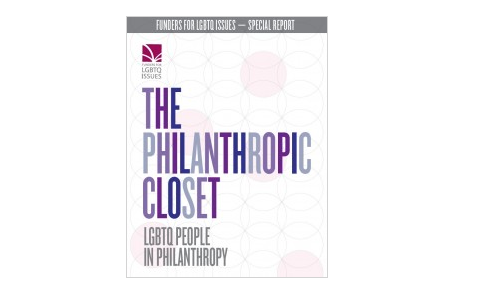One out of 10 LGBTQ people said they have left a nonprofit job due to an environment that was “not very accepting.” And, almost one-third said they were depressed at work because of an unwelcoming work environment.
“The Philanthropic Closet: LGBTQ People in Philanthropy,” the inaugural Diversity Among Philanthropy Professionals (DAPP) survey by Funders for LGBTQ Issues was conducted with support of the Evelyn and Walter Haas, Jr. Fund, in collaboration with SMU DataArts. Almost 1,000 individuals responded from 36 foundations that participated.
Lesbian, gay, bisexual or transgender people account for more than 16 percent of those on staff or boards of participating foundations, according to the survey, but the majority of those working in philanthropy are “in the closet,” meaning they have not disclosed their sexual orientation or gender identity to most work colleagues.
Some 42 percent of those surveyed at participating foundations were “out,” but those working at foundations with a social justice or LGBTQ focus were more likely to be out (52.5 percent) than those at foundations with another focus (30.7 percent). By comparison, the majority (54 percent) of LGBTQ people working the corporate sector are “out.” The Human Rights Campaign Foundation has found that 46 percent of the LGBTQ workforce in the United States remains “in the closet.”
Generally, LGBTQ people in philanthropy are more likely to be out the more senior they are within an organization. Among participating foundations, almost three-quarters of those who were out identified as board members and 62.5 percent as CEOs and senior staff. That proportion drops to closer to one-third among program, support, and other staff.
Multiple research efforts have confirmed that “out” LGBTQ employees enjoy greater job satisfaction, stronger job commitment, better health outcomes, and higher productivity when compared to “closeted” LGBTQ employees, according to the survey.
Unaccepting work environments can also lead to depression or sadness, with 31 percent of respondents reporting they experienced it while 25 percent said they were distracted from their duties. LGTBQ people can experience social isolation because they do not feel welcome at events such as holiday parties or happy hours. One in four LGBTQ people avoid certain co-workers and one in five avoid special events at work.
Unwelcoming workplaces can cause more than just emotional and social issues for LGBTQ people; they can also be the source of financial disparity. The survey cited statistics from a 2012 Gallup poll that found that more than one-third of LGBTQ adults earn less than $24,000 per year. Additionally, the Williams Institute at UCLA Law School found that one in four LGBTQ people struggled to put food on the table in 2016.
There are no federal regulations explicitly protecting LGBTQ people from workplace discrimination. In addition, 26 states do not have laws that expressly protect LGBTQ in the workplace. Nearly half of survey respondents reported living in a state that does not offer them protection in the workplace.
The lack of workplace legal protection for LGBTQ employees makes it vital for philanthropic organizations to do all they can to help ensure a welcoming environment, according to the report’s authors. Organizational leadership should create a zero-tolerance discrimination policy that is inclusive of gender expression and identity, as well as sexual orientation. Discrimination against LGBTQ employees should be handled in the same manner as gender or racial discrimination.
The report makes several recommendations for grant makers seeking to be more LGBTQ-inclusive:
- Make sure non-discrimination policies at your organization explicitly include protections based on sexual orientation, gender identity, and gender expression;
- Conducted targeted outreach to LGBTQ communities in your recruitment for staff roles, board positions, and committee positions;
- Make sure that your human resources policies are LGBTQ-friendly, such as, ensuring that your health insurance coverage provides benefits for LGBTQ families and covers transition-related healthcare costs for transgender employees;
- Treat LGBTQ discrimination the same way that you would treat racial or gender discrimination; and,
- Provide trainings on LGBTQ issues and create a culture where ongoing learning around cultural competency is not only encouraged but expected.
